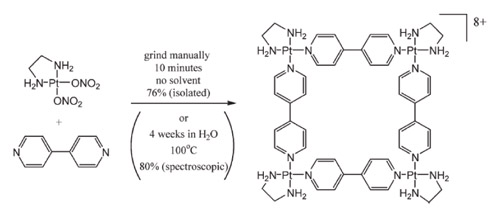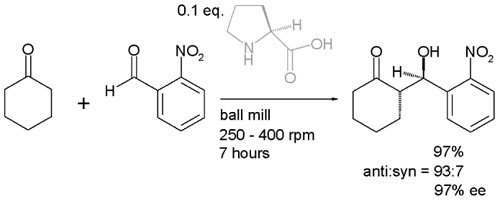 |
| |
|
|
|
|
| 引言 |
 友善列印 友善列印 |
感謝國內十餘位教授於繁忙的公務外熱心提供資料,並感謝中研院化學所提供製作網頁人力。
二十一世紀之良性社會發展倚靠公民參與精神之提昇。
目前資源共享網雛型已成,歡迎大家提供資料與改進方向,讓資源共享的精神促進科研之推廣與發展。 |
| 2006. 7 |
|
溶劑,顧名思義,可以溶解反應物,形成均勻的反應系統;溶劑可以調整反應物的濃度與溫度,控制化學反應進行的速率與方向;溶劑亦可用來萃取與分離特定的化合物。所以,在傳統的化學反應裡,溶劑的選擇經常是一個重要的課題。但是,溶劑,特別是有機溶劑是環境污染的主要來源。由於人類的環保意識日益覺醒,綠色化學逐漸形成一種新的科學哲學。所以,溶劑的選擇與化學反應的設計,必需加上環境因素的考量。至今,化學家已發展許多有機溶劑的替代物及綠色的合成方法:諸如離子液體、超臨界流體及水溶液合成等。但是,「最好的溶劑就是無溶劑」。(R. A. Sheldon, Green Chem., 2005, 7, 267.)近來,無溶劑合成(Solvent-free Synthesis)或乾介質反應(Dry Media Reaction)已逐漸被應用在許多固態的有機反應及一些無機反應上。其優點在於:
- 經濟(不需買溶劑)。
- 經常是計量反應(stoichiometric reaction),容易純化。
- 反應速率高(因為反應物的”濃度”高)。
- 對環境友善。
但是無溶劑合成亦有其固有之缺點:
- 反應物很難混合成均相系統。
- 反應系統黏滯性高,流動性低。大規模的自動化的生產較難。
- 不能進行需要溶劑分子參與的化學反應。
- 有些放熱反應,可能有散熱問題。
- 若產物為固態混合物,較難分離。(仍需溶劑分離)
為了使無溶劑合成反應容易進行,有時必須採取研磨(機械化學,mechanochemistry)、加壓等手段,或加以超音波震盪、微波照射等,以提供化學反應所需之能量。
|
|
| 實例 |
 |
無機方型超分子可以藉由研磨固態起始物 4,4’-bipyridine 及 [Pt(NO3)2(en)] (en = ethylenediamine)十分鐘得到。

A. Orita, L. Jiang, T. Nakano, N. Ma and J. Otera, Chem. Commun., 2002, 1362 |
 |
多孔性金屬有機架構(Metal-Organic Framework)可以藉由球磨法(Ball Mill)有效地在10分鐘之內合成產物。

Anne Pichon, Ana Lazuen-Garay and Stuart L. James,CrystEngComm, 2006, 8, 211.
|
 |
在一個Aldol reaction中,藉由球磨法(Ball Mill)研磨兩個反應物及不對稱催化劑(S-proline),可以得到高光學純度(Enantiomeric excess > 97%)的產物。

Belen Rodriguez, Toni Rantanen, and Carsten Bolm, Angew. Chem. Int. Ed.2006, 45, 6924.
|
| |
|
|
| 書籍 |
|
| Reviews |
 |
Waste-free synthesis and production all across chemistry with the benefit of self-assembled crystal packings — Gerd Kaupp, Journal of Physical Organic Chemistry 2008, 21, 630-643. A systematic mechanistic discussion of solid-state reactions (intracrystalline, intercrystalline, gas–solid thermal, or photochemical) at local molecular resolution is the basis for industrial sustainable production with waste-free solid–gas and stoichiometric solid–solid reactions at low energy requirement. These profit from the bargain of the self-assembled crystal packing.
|
 |
Organometallic chemistry in the melt phase — Muhammad D. Bala and Neil J. Coville, Journal of Organometallic Chemistry 2007, 692, 709. In this review organometallic chemistry reactions in the melt phase are described. As will be indicated this is a viable approach to make new and known complexes. Examples from the literature highlighting procedures used to generate melts and results that have been obtained in this area of synthesis are described.
|
 |
Solvent-Free Carbon-Carbon Bond Formations in Ball Mills — Belen Rodrguez, Angelika Bruckmann, Toni Rantanen, and Carsten Bolm, Adv. Synth. Catal. 2007, 349, 2213. Ball milling has been applied in numerous solvent-free carbon-carbon bond formations. In many cases, these transformations proved superior to the analogous reactions performed in solution. The reaction scope involves purely organic addition and coupling reactions, transformations involving metals (in stoichiometric and catalytic amounts) as well as asymmetric organocatalyses.
|
 |
Solvent-Free Organic Synthesis — Koichi Tanaka and Fumio Toda, Chem. Rev. 2000, 100, 1025. This article covers such solid-state organic reactions including the reactions that start with a solid, at least one solid reactant or solid catalyst, the reactions in the inclusion crystals, and organic solvent-free reactions mainly since 1983 although some review articles and books on these topics have been already published.
|
 |
A Green Chemistry Approach to Asymmetric Catalysis: Solvent-Free and Highly Concentrated Reactions — Patrick J. Walsh, Hongmei Li and Cecilia Anaya de Parrodi, Chem. Rev .2007, 107, 2503. This review describes progress in the area of catalytic asymmetric reactions under solvent-free and highly concentrated conditions. Despite the enormous potential economic and environmental benefits, this area has been largely neglected by practitioners of asymmetric catalysis and synthetic chemistry. The research outlined herein, however, clearly indicates that a wide variety of structurally unrelated catalysts exhibit high enantioselectivities and yields in the absence of solvent. In several cases, the reactions under solvent-free and highly concentrated conditions constitute the best conditions reported.
|
 |
Solvent-free synthesis of metal complexes — Ana Lazuen Garay, Anne Pichon and Stuart L. James, Chem. Soc. Rev. 2007, 36, 846. In this tutorial review we focus on recent research into the use of mechanochemistry (grinding) to synthesise metal complexes in the absence of solvent. We include synthesis of mononuclear complexes, coordination clusters, spacious coordination cages, and 1-, 2- and 3-dimensional coordination polymers (metal organic frameworks) which can even exhibit microporosity. Remarkably, in many cases, mechanochemical synthesis is actually faster and more convenient than the original solvent-based methods.
|
 |
Designed solvent-free approach toward organometallic networks built on directional metal–p-arene interactions — Marina A. Petrukhina, Coordination Chemistry Reviews 2007, 251, 1690. This work overviews our recent results on application of the gas phase deposition approach toward controlled formation of novel solid organometallic networks. Volatile electrophilic dimetal complexes of Rh(II), Ru(II), and Ru(I) and various organic p-donors have been used as complementary building blocks in co-deposition reactions.
|
 |
Dry media reactions — M. Kidwai, Pure Appl. Chem.2001, 73, 147. Dry media reaction under microwaves is an effort toward “green chemistry”. Effects of microwaves in dry media organic reactions have shown synthetic utility for the preparation of biodynamic heterocycles.
|
 |
Recent advances in solventless organic reactions: towards benign synthesis with remarkable versatility — Gareth W. V. Cave, Colin L. Raston and Janet L. Scott, Chem. Commun.2001, 2159. A paradigm shift away from using solvents in organic synthesis as solventless reactions can lead to improved outcomes, and more benign synthetic procedures, in for example aldol condensation reactions, sequential aldol and Michael addition reactions en route to Krohnke type pyridines, reactions leading to 3-carboxycoumarins, benzylidenes, 4-aryl-1,4-dihydropyridines and 2-aryl-1,2,3,4-tetrahydroquinazolines, and oligomerisation reactions for the synthesis of cavitands; kinetic considerations for the reaction of two solids can only be explained if a eutectic melt is formed during the reaction.
|
| |
|
|
| Articles |
 |
Thermal solid state synthesis of coordination complexes from hydrogen bonded precursors — Christopher J. Adams, Paul C. Crawford, A. Guy Orpen, Thomas J. Podesta and Benjamin Salt, Chem. Commun., 2005, 2457.
|
 |
Coordination polymers formed in solution and in solvent-free environment. Structural transformation due to interstitial solvent removal revealed by X-ray powder diffraction — Evgeny V. Dikarev, Bo Li, Vladimir V. Chernyshev, Roman V. Shpanchenko and Marina A. Petrukhina, Chem. Commun., 2005, 3274.
|
 |
Solid-state molecular syntheses: complete reactions without auxiliaries based on the new solid-state mechanism — Gerd Kaupp, CrystEngComm, 2003, 5, 117.
|
 |
Reversible Extrusion and Uptake of HCl Molecules by Crystalline Solids Involving Coordination Bond Cleavage and Formation — Guillermo Mnguez Espallargas, Lee Brammer, Jacco van de Streek, Kenneth Shankland, Alastair J. Florence and Harry Adams, J. Am. Chem. Soc. 2006, 128, 9584.
|
 |
Solventless Reactions for the Synthesis of Organotin Clusters and Cages — Vadapalli Chandrasekhar, Viswanathan Baskar, Ramamoorthy Boomishankar, Kandasamy Gopal, Stefano Zacchini, Jamie F. Bickley and Alexander Steiner, Organometallics 2003, 22, 3710.
|
 |
Paracyclophanes as Versatile p-Donor Ligands Directing Formation of Extended Organometallic Networks — Marina A. Petrukhina, Alexander S. Filatov, Yulia Sevryugina, Kristian W. Andreini, and Satoshi Takamizawa, Organometallics 2006, 25, 2135.
|
 |
Straightforward microwave-assisted synthesis of 2-thiazolines using Lawesson’s reagent under solvent-free conditions — Julio A. Seijas, M. Pilar Vazquez-Tato, Jose Crecente-Campo, Tetrahedron 2008, 64, 9280.
|
 |
The solvent-free synthesis of 1,4-dihydropyridines under ultrasound irradiation without catalyst — Shu-Xiang Wang , Zhi-Yan Li, Jin-Chao Zhang and Ji-Tai Li, Ultrasonics Sonochemistry 2008, 15, 677.
|
 |
Organic Synthesis in the Solid State via Hydrogen-Bond-Driven Self-Assembly — Leonard R. Mac Gillivray ,J. Org. Chem.2008, 73, 3311.
|
| |
|
|
| |
| |
|
| |
|
聯絡我們|國科會化學中心 |
| 本站適用瀏覽器為IE 6.0以上;最佳瀏覽解析度為1024*768 Update:
2020-09-08
|
| Copyright©2006 國科會化學中心. All Rights Reserved |
|
|
 |



